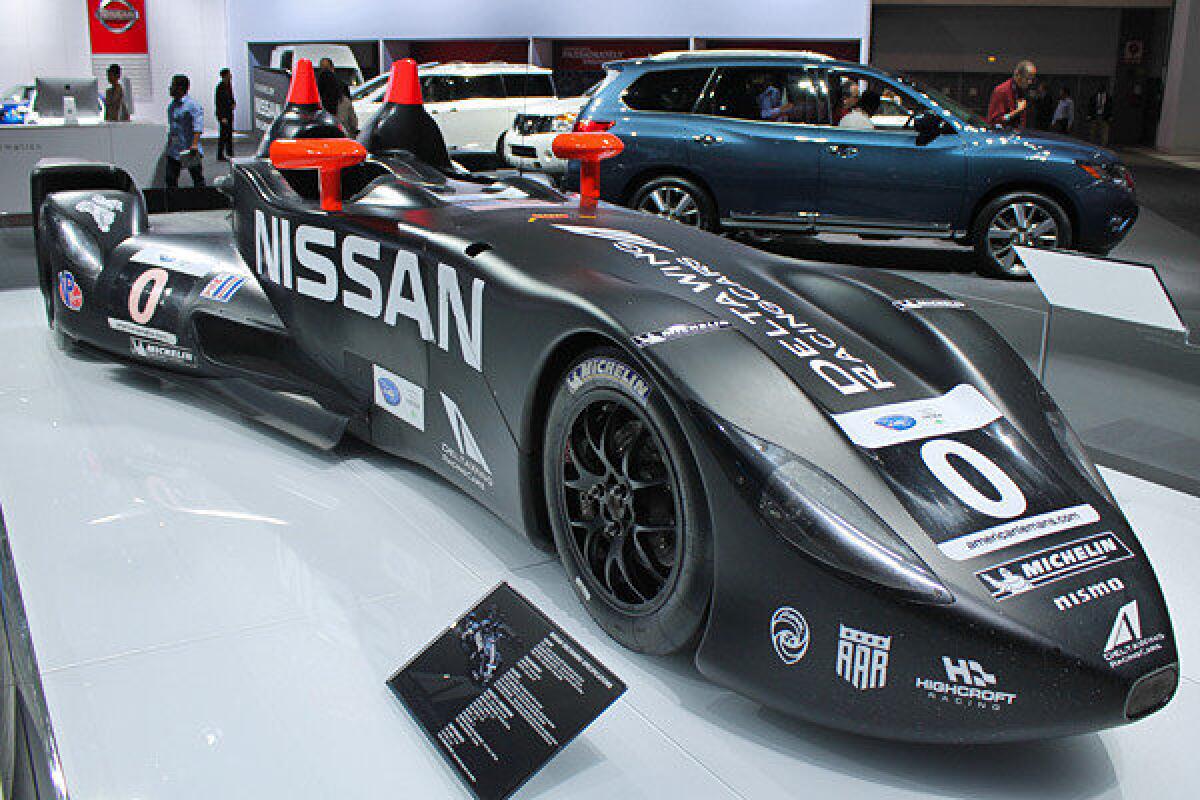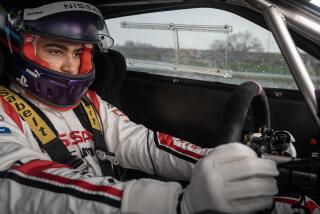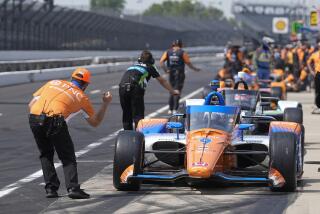L.A. Auto Show: Meet the man behind Nissan’s DeltaWing race car

Stroll over to Nissan’s booth at the Los Angeles Auto Show and you’ll see the usual collection of cars, trucks and SUVs, not unlike other automakers’ displays around the convention center.
And then you’ll see Nissan’s DeltaWing, a black rocket made from carbon composite.
The long, narrow body on the open-top experimental race car measures just 2 and a half feet wide from the nose, over the front wheels, to the driver’s elbows. From there, the car widens dramatically -- another 4.3 feet -- to cover the rear wheels.
Photos: Nissan DeltaWing at the L.A. Auto Show
“It looks like the Batmobile,” said Junior Ismael, a Canyon Country resident. “It’s real small. That’s what I was noticing. The wheels are not that big. It’s a nice-looking car though.”
Nissan aimed to wring the last drop of efficiency out of a car that can still compete with some of the world’s most technologically advanced race cars.
PHOTOS: Highlights from the 2012 L.A. Auto Show
“It was truly form following function,” said Ben Bowlby, the designer of the DeltaWing. “The objective was to show that we could maintain the performance of the premier status Le Mans sports cars and do it with half the fuel consumption.”
The designers started with few rules.
“We will throw away the regulations that define the bodywork and the drivetrain and so on, and we’ll see where we can get,” Bowlby said of the thinking during the car’s planning stages.
The resulting car has half the weight and half the aerodynamic drag of a conventional Le Mans racer. This allowed Bowlby and his team to use an engine that’s half the size and uses half the fuel.
The DeltaWing is powered by a relatively tiny 1.6-liter direct-injected, turbocharged four-cylinder engine. It makes 300 horsepower at a low 7,400 rpm and has 229 pound-feet of torque. The same basic engine is used in Nissan’s funky Juke crossover SUV, though Bowlby says the DeltaWing’s unit has been significantly modified with bits like titanium turbos.
The DeltaWing’s light weight means this engine is all it needs to hit speeds of 195 miles per hour in competition. The car’s curb weight is 1,047 pounds, about a third of what a typical compact sedan weighs.
This innovation has real-world applications, especially when it comes to helping Nissan meet stringent fuel economy regulations in the U.S. by 2025, Bowlby says. “A top executive at Nissan now knows yes, the way the DeltaWing halved its fuel consumption and tire consumption was by reducing drag, reducing weight and downsizing the engine. The physics translates absolutely.”
But the learning process wasn’t all about finding a path to efficiency.
“There are some very interesting vehicle dynamic features that fell out of the project,” Bowlby says. When pressed on what he means, the designer laughs. “It’s a heck of a fun thing to drive.”
It was also an easy car to drive. The designers were initially concerned that the DeltaWing would have a steep learning curve for drivers. That proved not to be the case. “It takes them two corners, and they forget all about the fact that their car is different,” Bowlby said. “They have their spatial awareness worked out.”
That awareness was put to the test in June as the car was entered in the prestigious and grueling 24 Hours of Le Mans race in France. Unfortunately, it ended up being the other drivers Bowlby needed to worry about; the DeltaWing was forced to retire after a little more than six hours of racing when a Toyota driver from the elite LMP1 class knocked the DeltaWing off the track and into a wall.
In October, the Nissan found success, finishing fifth in the 1,000-mile Petit Le Mans race in Georgia.
With such race success came a greater public awareness of the car, Bowlby said. “I think it was a litmus test. Was innovation interesting to the public? I mean it was the fan favorite, it was crazy.”
Others already knew about it. Mike McCarthy came to the L.A. Auto Show from Huntington Beach. An amateur racer himself, McCarthy said he’s been following the development of the DeltaWing for some time.
“I think it’s just a fantastic concept: half the weight, half the horsepower, just as fast, twice as efficient,” McCarthy said as he admired the DeltaWing. “It’s somebody that thinks outside the box, and it’s successful. That’s fun to see. I hope to see it race more often.”
McCarthy may get that chance. The car was recently approved to run in the 2013 season of the American Le Mans Series, though there’s no word yet on a final decision from Nissan and team organizers.
If that doesn’t happen? Bowlby smiles cryptically. “I think there’s a lot of exciting challenges out there.”
ALSO:
Full coverage: 2012 L.A. Auto Show
PHOTOS: Highlights from the 2012 L.A. Auto Show







